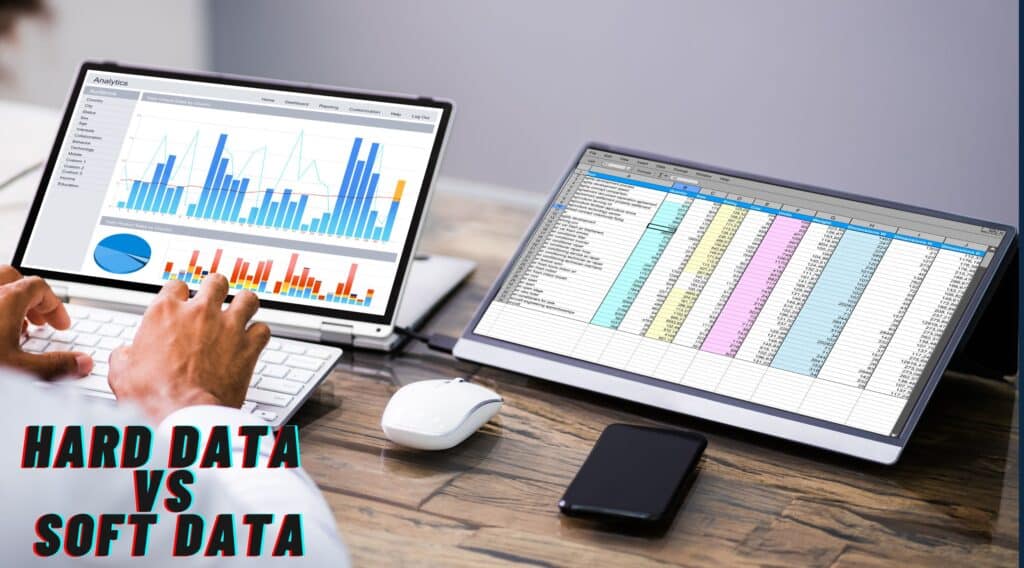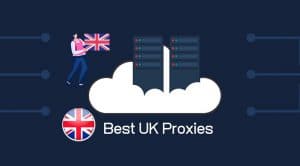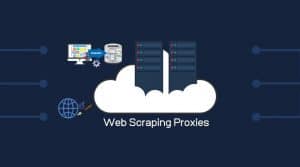Do you know the differences between hard and soft data and why they are an important asset to your business or analysis? In this article, we have explained clearly what hard and soft are, their types, benefits, and their core demerits.

Data is a very crucial entity in the world today. When it comes to analyzing its value, it is that soundless identity that makes information to become an asset. With the rise of the internet, information access is now flexible. Nevertheless, to be clear about this is to know that data is what gives us this information. Whether or not you own an enterprise or you are just an ordinary layman, there is a need for data gathering. This data can be from your competitor, from your business, or any means. This is important because it will allow you to know what is happening in and out of your reach.
However, to completely get the gist is to know entirely what these data are. Categorically, data are either Hard or Soft. Though these terms might seem technical, they are essential in understanding where, when, and how decisions are settled in business, research, and your day-to-day activities. In this article, we will look at what hard and soft data are, the types, benefits, similarities, comparisons, and as well the demerits. Without further ado, let’s dive right in.
Soft data and hard data are key concepts in data analysis and research. Here are some examples to illustrate each,
Hard Data Examples
- Financial Data: Exact figures like a company's annual revenue of $50 million, or a 5% increase in quarterly profits.
- Clinical Trial Results: Blood pressure measurements of patients using a new medication, showing an average decrease of 10 mmHg.
- Traffic Data: A report stating that 30,000 vehicles pass through a certain intersection daily.
- Educational Scores: Data showing that 80% of students passed a standardized math test with an average score of 75%.
- Retail Sales: Exact sales data indicating a store sold 500 units of a product in a month.
Soft Data Examples
- Customer Satisfaction Surveys: Responses to a hotel stay where guests rate their experience as ‘satisfactory', ‘good', or ‘excellent'.
- Employee Opinions: Feedback from a company survey where employees describe the workplace environment as ‘supportive' or ‘stressful'.
- Market Research Groups: A focus group for a new product where participants describe the product as ‘innovative' or ‘unnecessary'.
- Performance Reviews: A manager's qualitative assessment of an employee's performance, describing them as ‘highly motivated' and ‘team-oriented'.
- User Experience Research: Observations from testing a new app where users report finding the interface ‘intuitive' or ‘confusing'.
What is Hard Data

Hard data are often called factual information. These are data that consist of objective and quantifiable information derived from reliable and legitimate sources. Hard data are measurable and often expressed in numerical terms. This data type is typically based on verifiable facts and observable evidence which include statistics, numerical measurements, survey results, financial figures, and other empirical observations. They are objectively measured, and usually presented on figures, graphs, and tables. What this tells you is that, this type of data is not partial or biased, because it cannot be influenced by emotions. Thus, why it is reliable.
Knowing that this data is independent and factually based, to come correct with it while collecting data always requires a suitable methodology or technological approach i.e., rules. This is to make sure that the result which is going to be the information has been well proven, hence it is effective and valid. Gathering hard data can be from any source or context. The most important thing is for it to be quantifiable. Some sources may include, computers, business sales revenue, and web traffic. In addition, there are figures, number of units sold, and even from your smartphone. Note that analysis of data is highly paramount in hard data.
Types of Hard Data

Hard data comes in various forms depending on the information being measured. Nonetheless, based on sources and collection methods, there are four types of hard data. These are:
Primary Hard Data
primary collection of hard data is the initial stage and pure form of data. This data is commonly done through mathematical and scientific processes. Since it is quantitative, some methods used for its gathering are through questionnaires, and precisely close-ended, statistics among others. Analysis of the data in this method is fair because it is scientific, hence, no influence of any feelings. Meaning that the analysis is not subjective but rather objective. Also, the outcome is not biased, they follow certain guiding principles, and as a result, they are accurately reliable.
Secondary Hard Data
Secondary data collection, just as the name implies is simply gathering data from secondary sources. These are sources that are related and of good credibility to your interest area. These include newspapers, journals, books, research documents, and scientific reports to mention a few. These sources are of various aspects, so, you will have to set certain criteria for validation. This in turn will enable the reliability of the data. These criteria may include, the author's authenticity, date of publication and other parameters you deem fit will be valuable to your area of interest. The uniqueness of this method is that since it does not require producing any new data, it is fast and requires less effort.
Technological Hard Data
Technological data can be said to be one of the purest because of the ability to easily verify and trace back the source of its collection. Technological generated data can be measured. Thus, it can be collected from devices and machines such as mobile phones, applications, computers, and monitoring software. On top of that is also a scraping tool, web traffic, and many more. This method has gradually gained grounds knowing the fact that its reliability and credibility can be determined and quantified.
Research Hard Data
Data collected using this method is that which is methodological. The analysis is more experimental and survey-oriented. The data collection is from the research carried out by professionals and some experts in a certain field of interest. Most importantly, these authorities must be holding credible grounds for you to be able to collect data from them. It is part of what ascertains the legitimacy of the data. The good that comes with this method is that, is a well-organized and structured method. Therefore, it is verifiably reliable.
What is Soft Data

On the other side is soft data. This is qualitative and subjective. These data types are often non-numerical information, more abstract observations that are opinionative and interpretive. This data can include, customer reviews and more. What’s most essential is for it to be non-numerical and qualitative. Take for instance, if you run an eCommerce store, soft data will include the comments from your customers, feedback, and quality of the service you render to mention a few.
Moreover, on research grounds, this could be peer reviews, participant observations, and interviews. The technique behind it is that, soft data is more into being conversational and engaging. This means that your personal experience from shared discussion can come into play. Insights and depth of data are clearer with soft data. They will help you understand why figures are what they are, by attaching emotions and experience into the context of data gathering.
Types of Soft Data
Just as there are several types of hard data, there are also several forms of soft data. Among these are the few that will be discussed below.
Interview
Soft data has quite different methods of collecting data. Unlike hard data, it is more of the analogous strategies rather than being methodologically analyzed. Soft data has to do with engaging people or customers in conversation. Like open-ended talks that might be agreed upon or disagreed on. Here, the opinions, criticism, reviews, feedback, and ideas are put into consideration. Knowing it does not deal with factual data, the ground is open for anyone to be personal. Because of this, the outcome of the findings cannot be generalized to be of precisely scientific rules., Feelings can come into play, so, it is subjective.
Observational Data
Using this method, the Insights are usually gained through direct observation. Oftentimes, it involves qualitative descriptions of behavior, interactions, phenomena, or experiences. Opinions can be expressed on social media platforms. Though this can be a bit challenging to quantify but offers insights into public sentiment.
Focus Group Response
Focus group as a type of soft data works like the interview method. It uses an analogous technique. Customers or people are engaged in open-ended conservation to retract information from them. The difference between the method and the interview is that the focus is on a specific audience or group. It is qualitative data obtained from discussions among a group of people, exploring their perspectives and opinions on a particular topic. Customers are asked questions based on their interest area, and your target. The response is open, as such, the client’s motivation and needs can easily be assessed and known.
Internet or online soft data
Online soft data are common in this day and age. Several soft data can be gathered through the internet. All that is needed is to know the site and the right tool to use. Soft data that can be collected from online space include but are not limited to product reviews, sentimental analyses (negative or positive), customers' brand perception, interest, suggestions, experience, and many more. The good that can arise with this is that this data will help you get into your customers' heads, and know and understand them better. Additionally, you can assess what moves them and how you as a business owner can get better.
Benefits of Hard and Soft Data

The benefits of hard and soft data get down on their pros. In this section of the article, let’s fish out some of them.
Hard Data
- Hard data is quantifiable and can be measured. This will enable easy and flexible comparison and data analysis.
- Hard data offers precise and accurate information through quantifiable metrics, providing a reliable footing for decision-making.
- Objectivity is one of the major beneficial features of hard data. The nature of hard data promotes objectivity and reduces the impact of individual interpretation. And, also biases in decision-making processes.
- Hard data is beneficial to statistical, mathematical, and scientific analysis. It allows the application of various statistical tools to extract robust insights into what motivates customers and the current trends.
- Hard data is based on empirical evidence; thus, it is data-driven. With hard data, the emphasis lies on factual and verifiable numerical data rather than intuition or subjective opinions.
Soft Data
- Soft data is qualitative in nature. The benefit this brings is that it provides favorable insights into the behavior of your customer.
- Soft data is deeply contextual and therefore it provides understanding by being opinionative and interpretive.
- Soft data often complements hard data to ensure a more generalized analysis.
- Soft data has nothing to do with numerals. It provides information that is relevant to specific contexts. Thereby making sure to see through and make available what the audience prefers.
- Since soft data is qualitative. Its focus is on contributing clearly to the understanding of issues and why they happen.
Similarities Between Hard and Soft Data

Both hard and soft data have their distinct attributes, nonetheless, there are some similarities they share. Let’s outline and discuss what they are.
-
Dynamic Nature:
One major similarity between hard and soft data is that they are both subject to changes over time. Frequently updating to check what’s new, may be necessary to maintain the significance and accuracy of the information. As customer preference increases, so does the type of data they will need. By reassessing, you can tell if the sentimental analysis and feedback of previous reviews were the same as the current one or if they vary.
-
Decision Making:
The decision-making process is a part of the core result of both hard and soft data. Data-gathering procedures are initiated from scratch or at a secondary level to make decisions. Therefore, both types of data can facilitate decision-making processes. Hard data provides quantitative data for more objective decisions. Whereas, soft data goes all qualitative to provide subjective insight.
-
Complementary Nature:
It is said that there is no perfect hard data without soft data. This is because in most cases hard and soft data complement each other. The coming together of quantitative metrics of hard data with qualitative insights of soft data will lead to a more comprehensive and clearer understanding of the context and situations you need the data for.
-
Research:
When it comes to research, it is also a key reason why data are needed. The value here is that, either for a self-owned enterprise of scientific data gathering, researchers go with a combination of both of these data types to carry out thorough inquiries. The integration of both hard and soft data will allow for a more robust and complete analysis of a research area of focus.
-
Issues of Validity:
In as much as validity is important, it becomes a concern to both of these types of data. Both hard and soft data can face issues of validation. Why because they both vary in some aspect. Hard data may likely get influenced at a point by measurement errors. Whereas, soft data is subjective and prone to bias. Even at that, ensuring there is a reliability score for both types of data is vital.
Comparison Between Hard and Soft Data

Having seen the similarities between both hard data and soft data, you need to note that there are debating grounds as to their differences. In this section of the article, we will list and explain some core differences that arise between these data types. Now, let’s get these clearer.
-
Measurability
Hard data is quantifiable and measurable. It is expressed in numerical terms such as statistics and measurements. Soft data on the other hand is qualitative, therefore, it is not measurable in numerical terms. It involves more abstract qualities and attributes, such as perceptions, and attitudes of clients. Measurability is one distinct characteristic that sets hard data aside from soft data. It can simply be said that hard data is tangible information while soft data is intangible information.
-
Analysis
Although soft data provides information-rich features that hard data lacks, soft data can be easily influenced by baseness since it is subjective. This is because soft data is difficult to analyze. And, analysis of data is core in hard data, as it drives results and decision-making. Albeit the insight and in-depth which soft data provide, hard data is not biased and not influenced by any feelings. That is why hard data is more reliable and verifiable. Whereas, soft data is difficult to analyze.
-
Data Form and Nature
Soft data are typically non-numerical, they are narrative in information format. While, hard data are numerical, majorly represented by numbers, graphs, and tables. On top of that, in terms of nature, hard data are factual and composed of facts and evidence. In contrast, soft data is more of the interpretive and abstract of observation. Examples of hard data are statistics, mathematical calculations, and sales figures to mention a few. Soft data are exemplified by opinions, sales reviews, customer feedback, client motivation, and perception among others. Unlike soft data, hard data can be used for generalization or prediction.
-
Methodology
Unlike hard data, soft data does of follow any research method. Soft data is usually based on opinions, sentiments, interpretations, and even assumptions. Because of these attributes of soft data, it is seen not to be reliable. But, what’s for sure is that there is no trustworthy or perfect hard data without soft data in the world of business. This is because what businesses need is what soft data constitutes. Many businesses today rely on penetrating their customers deeply to get reviews, feedback, and criticism to further understand their customers. Why this is pivotal is that, with this soft data, they will be able to know the need of their customers and what motivates them and make them buy. Hard data is complemented by soft data to yield solid functionalities.
-
Varies in Sources
There are various ways hard and soft data are sourced and collected differently. While, soft data are being sourced from a variety of channels, including surveys, interviews, abstract observations, focus groups, online, and experiments. Hard data are sourced and collected primarily by conducting research or creating new data. The secondary sources are newspapers, journals, books, and more. What to keep in mind is that the choice of data type depends on the research question or the information you need or want to collect.
-
Reliability and Verifiability
Hard data is normally seen to be reliable due to its objectivity. Most importantly, hard data is generally more verifiable because it is factual. In contrast, soft data reliability is subject to interpretation from the sources obtained. This interpretation may sometimes vary by individual, but it is the prime determinant of the credibility of the soft data gathered.
Demerits of Hard and Soft Data
Looking at everything that has been explained so far, it is also essential to know the drawbacks, demerits, or disadvantages hard and soft data possess.
Demerits of Hard Data
There are quite a few drawbacks of hard data, these are:
- Inaccuracy: Even though hard data are reliable, there can be some inaccuracy sometimes. Errors are not completely inevitable; therefore, measurement errors can occur. This inaccuracy error can be based on biases in data collection, or incomplete datasets. Relying only on quantitative metrics may result in defective analyses as well.
- No Context: Hard data is not comprehensively understandable and clear. This arises because it’s measurable and precise. Hence, it lacks the capability of measuring the intangible numbers which may show further deep insight.
- No Human Capturing: Hard data is often lacking in terms of capturing human feelings or emotions, motivations, and behaviors. As a result, it does not provide a complete view of complex human interactions like feedback, sales reviews customer perception towards products and brands etcetera.
- Inflexibility: Hard data is not flexible and may not adapt well to changing circumstances. Unlike soft data, hard data is rigid, and not so dynamic. What this tells you is that, it will not effectively capture all current trends or qualitative modifications.
Demerits of Soft Data
Soft data has its drawbacks also, these are:
- Bias and Subjective: Since soft data is qualitative, it is inherently subjective, making it susceptible to individual biases and interpretations. Different persons might perceive and interpret the same information differently. With this, one observer may be more emotional than another, as such, results in bias. Soft data is not 100% justifiable and verifiable.
- Interpretation-Driven: The credibility of soft data always relies heavily on interpretation. This might present some level of uncertainty. Different analysts may derive varying conclusions from the same set of soft data. The red flag here is that, without this interpretation, soft data validity and reliability can’t or will be difficult to determine.
- No Precision: unlike hard data, soft data lacks the precision of hard data, making it thought-provoking to quantify and compare. This can limit its usefulness in certain analytical contexts and situations.
- Difficult to Quantify: Soft data, especially qualitative information, may be challenging when it comes to consistent and frequent quantification. This can impact the reliability and credibility of findings in a scenario where measured data are needed. Moreso, this can limit its utilization and importance in situations where numerical precision is deemed paramount for strict decision-making.
FAQs About Hard and Soft Data
Q. Why is Hard and Soft Data Important?
Hard and soft data are crucial for several reasons. They are important for research and analysis. For decision-making, statistical insight, understanding the performance and credibility of data, as well for measurement among other reasons. Soft data sometimes complements hard data to yield a clearer result in terms of more insightful data gathering. Even though there are debates as to which of these data types is more important, both hard and soft data are essential to get the right information for your sales or scientific research.
Q. How Can I Effectively Collect Hard and Soft Data?
There are various methods to be used in the collection of hard and soft data. You can effectively collect hard data through surveys, questionnaires, technology, and primary and secondary sources, like newspapers, journals, books, and research. For soft data, you can simply gather its data through targeted focus groups, peer reviews, interviews, abstract observation, online space, and via experiment. These are just a few ways. So, collecting hard and soft data is not limited to these methods alone. There are other ways like creating polls, votes, and more.
Q. What is the Primary Difference Between Hard and Soft Data?
The main difference between hard and soft data is clearly stated as their names imply. Hard data are those data that are measurable, objective, and often represented by facts. As such they are seen to be quantitative. Whereas, when talking about soft data, you are down on subjective data which involves interpretation, narratives, and opinion. Hard data are numerical while soft data are non-numerical. Understand that both data types are very crucial and valuable depending on the context and decision-making process at stake.
Conclusion
The difference between hard data and soft data is vital in understanding how different information is gathered. Hard data also known as factual data, is quantifiable, measurable, and objective whereas, soft data, is subjectively qualitative and needs deep insight for proper interpretation. In this article, we have covered everything you need to know about soft and hard data with the inclusion of their types, benefits similarities, and several examples for quick comprehension.






